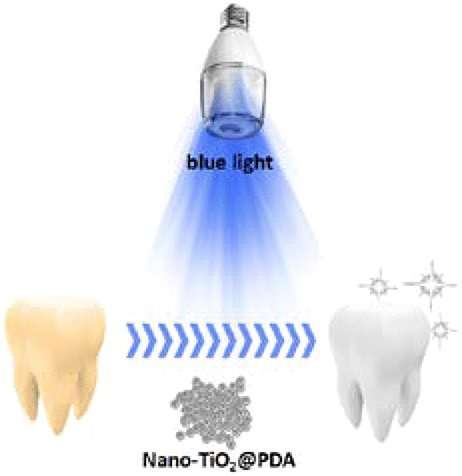A safe and effective way to whiten teeth

In the age of Instagram and Snapchat, everyone wants to have perfect pearly whites. To get a brighter smile, consumers can opt for over the counter teeth-whitening treatments or a trip to the dentist to have their teeth bleached professionally. But both types of treatments can harm teeth. According to an article published in ACS Biomaterials Science & Engineering, researchers have now developed a new, less destructive method.
Teeth can become discolored on their outer surfaces when people consume colored foods and drinks, such as coffee, tea or red wine. As a result, many people turn to non-invasive whitening treatments that bleach the teeth. Currently, the most common bleaching agent is hydrogen peroxide, which steals electrons from the pigment molecules that cause teeth discoloration, and this process can be sped up by exposing teeth to blue light. But high concentrations of hydrogen peroxide can break down a tooth's enamel, causing sensitivity or cell death. So, Xiaolei Wang, Lan Liao and colleagues wanted to see if a different blue-light-activated compound could be a safer, but still effective, alternative.
The team modified titanium dioxide nanoparticles with polydopamine (nano-TiO2@PDA) so that they could be activated with blue light. In a proof-of-concept experiment, the nano-TiO2@PDA particles were evenly coated on the surface of a tooth and irradiated with blue light. After four hours of treatment, the whitening level was similar to that obtained with hydrogen-peroxide-based agents. The group notes that no significant enamel damage was found on the surface of the tooth, and the treatment was significantly less cytotoxic than hydrogen peroxide. In addition, the nano-TiO2@PDA therapy showed antibacterial activity against certain bacteria.
More information: Feng Zhang et al. Blue-Light -Activated Nano-TiO2@PDA for Highly Effective and Nondestructive Tooth Whitening, ACS Biomaterials Science & Engineering (2018). DOI: 10.1021/acsbiomaterials.8b00548
Abstract
The application of polydopamine (PDA)-modified titanium dioxide nanoparticles (nano-TiO2@PDA) as a new blue-light-activated tooth whitening material was discussed for the first time. Compared with the classical clinical whitening agent (peroxide, hydrogen peroxide, and carbamide peroxide), nano-TiO2@PDA-based treatment not only had a similar whitening effect but also showed remarkably less damage on the enamel structure. Essentially, a highly effective and nondestructive tooth whitening treatment could thus be realized accordingly. The toxicity and antibacterial properties of this material were also evaluated systematically.
Provided by American Chemical Society




















